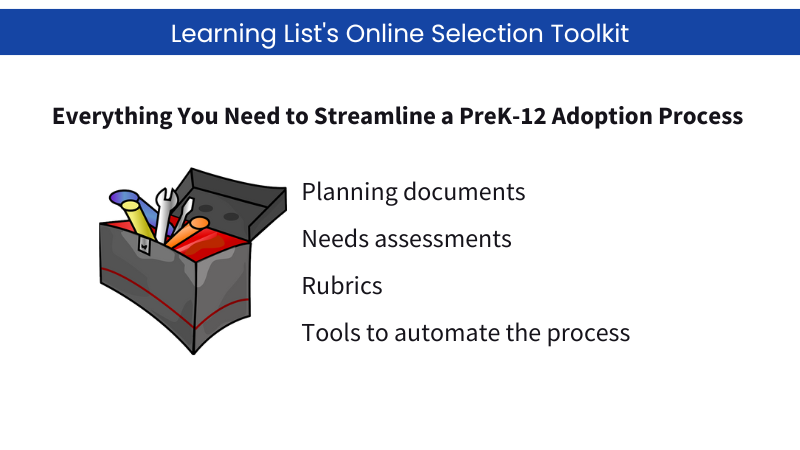In the first two blogs in this series, we offered guidance for planning an instructional materials adoption and customizing a rubric to reflect your district’s priorities. Generally, districts would use that information when selecting core materials. Supplemental materials are most commonly selected at the campus level, and campus leaders typically rely on word of mouth (Wang et. al., 2019) when it comes to selecting new instructional materials.

While core materials are more expensive than supplemental resources, most districts spend more money on supplemental resources overall, given the number of supplemental materials purchased each year. Moreover, supplemental resources are often used to remediate struggling students. Thus, it is just as important to select standards-aligned, high-quality supplemental materials as core materials.
To ensure that campuses purchase high-quality supplemental materials, implementing a structured process for reviewing and selecting supplemental resources would be prudent. Since supplemental materials are not as robust as core materials, a pared-down review process such as the one described below would suffice.
(1) Articulate the need for the adoption.
While a change in state standards is typically the impetus for selecting new core materials, many other factors compel districts/campuses to purchase new supplemental materials. For both financial and political reasons, district or campus leaders would be wise to document clearly why new supplemental materials are needed.
(2) Establish a timeline.
When developing a timeline for selecting supplemental materials, it is wise to work backward from the date the material must be in the classroom. Given that many supplemental materials these days are digital, be sure to allocate sufficient time for teacher training on how to use the new material.
(3) Identify the selection committee.
The makeup of the selection committee should depend on the type of material being adopted and the number of teachers who will use it. To secure buy-in for the material selected, a representative sample of the teachers who will be using the new material, as well as staff who will be supporting its implementation, should be on the selection committee. Including both experienced and inexperienced teachers will help ensure that the material selected will support teachers with a wide range of experience.
(4) Document the review process logistics.
To avoid delays in the process, document and communicate to the selection committee members where, when, and how they should access the product samples they will be reviewing and the date by which reviews must be completed.
(5) Identify the non-negotiables.

Just as for the adoption of core materials, district or campus leaders should identify the non-negotiables for the adoption of supplemental resources. Non-negotiables may include the budget, the minimum alignment percentage, the material’s format, and the required supports for students.
(6) Distribute a needs assessment.
Before selecting a new supplemental material, it is important to gather feedback about the features teachers want and/or need. An easy way to do this would be to distribute a needs assessment survey to all teachers who will be using the new material and staff who will be supporting its implementation. The aggregated results of the needs assessment will provide the list of features teachers believe the new supplemental material must have to support their students.
(7) Narrow the number of materials to be reviewed.
Put together a list of supplemental materials to consider. The Learning List, a new, directory of K-12 instructional materials can save you hours of work. Then, use the list of non-negotiables and the needs assessment results to narrow the number of materials the selection committee will review. Optimally, the committee will review between three and five materials.
(8) Develop a rubric/checklist of features for the selection committee to use for their reviews.
In our previous blog Customizing an Instructional Materials Rubric To Reflect Your District’s Priorities, we discuss the benefits of using a rubric in an adoption process. For the selection of a supplemental resource, the same benefits could likely be achieved by developing a checklist of features rather than a full-blown rubric. The list of non-negotiables, the needs assessment results, state standards, and best practices for the content area and type of material being adopted may be useful resources when developing the checklist. Using a features checklist to select supplemental materials will ensure consistency in the review process and provide data to support a selection decision.
(9) Test the features checklist.
As with a rubric, once the features checklist is complete, it would be prudent to run it by a few of the teachers who will be using the material that will be selected to make sure that the checklist (a) includes the features they believe are necessary, and (b) is a reasonable length. In the case of rubrics and checklists, more is not necessarily better. If the checklist is too long, selection committee members may not use it with fidelity to review each material, which would distort the data and could lead to the selection of the wrong material.
(10) Train the selection committee.
It is important to provide training to ensure that all committee members understand the features listed in the checklist and how each is likely to be reflected in a material. For example, if one of the features on the checklist is alignment to standards, selection committee members need to understand what alignment means and how to evaluate a supplemental material for alignment to state standards.
(11) Review the materials.
While it may be necessary to allow committee members to review the materials on their own time, we have observed that convening reviewers in a room while they review the materials independently facilitates important, spontaneous conversations that lead to deeper reviews of the materials and consensus building around which material(s) meets the campus/district’s needs best.
(12) Analyze the data and reconvene the selection committee to make a final selection.
Once selection committee members have submitted their completed checklists, the person managing the selection process should analyze the responses to determine which material(s) contain(s) the greatest number of checklist features. The selection committee should then be reconvened to discuss the data with the goal of reaching a consensus about which material to select.
The rationale for selecting that material should be documented clearly and communicated to the teachers who will be using the new material. Maintain The documentation should be maintained for several years in case the district’s use of the selected material is ever challenged.
Research suggests that supplemental materials are most often selected at the campus level based on referrals from colleagues rather than as a result of a structured vetting process. Given how much districts spend on supplemental resources, the important role these materials play in preparing students for academic success, and the potential for a challenge by parents and/or community groups, adopting a structured process for reviewing and selecting supplemental materials would be prudent.

Less time-consuming than the process for reviewing core materials, the process suggested in this blog solicits feedback from the relevant teachers, facilitates consistent reviews, and produces data to support the selection decision(s).
If your district needs assistance selecting core or supplemental materials, contact us. Our reviews and comparison tools, online professional development courses, and selection toolkit or selection facilitation service, provide increasing levels of support.
Wang, E., Tuma, A., Lawrence, R., Kaufman, J., Woo, A., and Henry, D. (2021) School Leaders’ Role in Selecting and Supporting Teachers’ Use of Instructional Materials: An Interview Study. RAND Corporation. https://www.rand.org/pubs/research_reports/RRA134-9.html.
